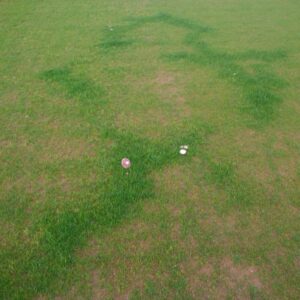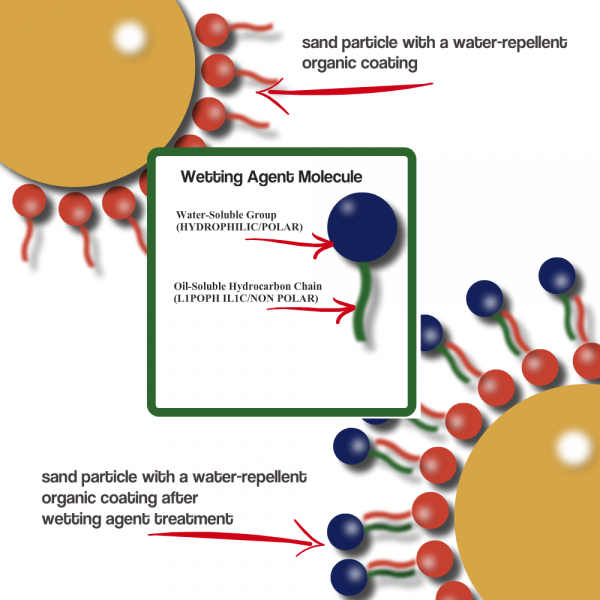
Dealing with Fairy Ring in fine turf is a common requirement on greens that are out of balance. In fact fairy ring is just another of the symptoms of the Circle of Decline, which we’ve discussed in detail here many times. A common problem in fine turf on bowling and golf greens, fairy ring is the result of the activity of a group of soil fungi called basidiomycetes. The various species of basidiomycetes have roles in the soil eco-system related to the break down of organic matter. This process releases nitrogen, which then causes the trademark green rings as the grass experiences a flush of growth spurred on by the extra Nitrogen suddenly available to it. With some species’ a by-product of this process is a protein that coats individual sand particles, causing them to become hydrophobic. As a result of this, the rings will eventually become bare and similar in appearance and disruption to Localised Dry Patch. In fact the two conditions are closely related in terms of cause and effect.

Fairy ring is just another symptom of a green eco-system out of balance, but of course can cause problems while it remains in place. The flushes of green growth in the rings can cause the speed, smoothness and trueness of the green to suffer, as can the hydrophobic soil patches when they lose grass cover and start to shrink below the general level of the green surface.
In a healthy green with a full compliment of soil microbes, it is rare for imbalances like this to occur, so the main aim should be to get the green eco-system into balance to avoid these outbreaks in the first place. When the soil is in healthy condition, domination by any problematic fungi like basidiomycetes or fusarium for example is less likely due to the soil microbial populations keeping each other under control.
Using fairy ring as your excuse to break the circle of decline
When discussing the Circle of Decline with bowling and golf clubs the question that most often arises is “where do we start?” The answer is often frustrating to the enquirer, as there is no optimum time or place to start, but it’s important to start somewhere and start immediately if you can. Fairy ring then, is in many ways a gift as it provides a pressing reason to get started. It is a symptom of the underlying problems and if dealt with correctly, the work you do to eradicate fairy ring will add greatly to your efforts to break your green out of the circle of decline.
Thatch eating fungi can out compete fairy ring fungus.
The soil microbial population of fungi, bacteria, nematodes and others are locked in a constant struggle for domination and survival. In a well balanced and healthy soil, this is largely kept in balance naturally, but when we tip the balance in the favour of any particular species through the use of inorganic fertilisers, fungicides or by applying too much sand, we make it more likely that problems will occur. Basidiomycetes (fairy ring) can be outcompeted for nutrient by a wide range of the thatch eating fungi we are trying to encourage as part of our program to return our greens to a perennial, fine grass dominated sward.
Action Plan (don’t do more of the thing that got you here in the first place)
You might read about the possibility of dealing with fairy ring by using fungicides, or even be advised to use such an approach. Fungicides are part of the reason you have fairy ring in your turf in the first place so please don’t fall for this. Applying fungicide now is a sure way to cast your green back into another spin on the Circle of Decline.
The correct action plan is clear and simple.
Improve the Microbial Balance of your soil
- Make holes; aeration by mini tining or sarrell rolling will create a physical access point for wetting agent and compost tea as well as introducing more oxygen which is always good as far as aerobic microbes are concerned.
- Apply Compost Tea with a Fungal Additive (to ensure the full compliment of thatch degrading fungi are present).
- Use a suitable wetting agent such as Hydroaid.
If needed you can also add Humic and Fulvic acids to the green at this time. These are a major part of soil organic matter and can be used to stimulate beneficial soil fungi populations, increase soil cation exchange capacity and provide organic and mineral plant nutrients for improved plant growth. This is particularly important in greens with high sand content as the readily available humate substances are limited and should be added regularly during the growing season to feed the fungi and bacteria that form the foundations of the soil food web. A Humic Booster can be applied fortnightly until the fairy rings disappear.
Localised Dry Patch

A similar approach can be used for the long term eradication of Localised Dry Patch (LDP). Again we’ve discussed LDP extensively on Bowls Central so I won’t go over old ground about the causes here, but it is a very similar issue to Fairy Ring in that sand particles become hydrophobic (unable to attract water) due to a waxy organic coating on the individual particles of sand. Research is still ongoing, but it seems in many cases that this organic material is a by-product of organic matter decomposition. When a large enough proportion of a sand particle is coated like this, it will become water repellent.
Research has shown that it takes as little as 6% of the total sand particles in a rootzone to be coated to cause extensive problems with LDP.
Wetting agent molecules have a polar, hydrophilic (water attracting) end and a non-polar end, so when the wetting agent is added to the water, the polar end bonds with water molecules (water molecules are dipolar in that they have two positively charged Hydrogen atoms and one negatively charged Oxygen atom) and the other, non polar end bonds with the non-polar organic coating on the sand particle. This allows the soil to re-wet, albeit temporarily, it isn’t a cure, just a treatment for the symptom.

The re-wetting effect will last as long as sufficient wetting agent remains bonded to the sand particles, but water repellency and the associated dry patches will return when this is no longer the case. That is why it is important to work on the soil eco-system as a whole to effect a cure for the underlying issues of imbalance brought about by excess sand and the routine use of inorganic fertilisers and fungicides over decades.
Disease Management
Degrading thatch will combat disease by increasing the availability of the whole suite of nutrients and soil conditions that promote stronger plants. This can be helped along by stopping or significantly reducing the use of inorganic fertilisers. The mineral salts contained in these kill off beneficial fungi and encourage the weak growth patterns that make plants susceptible to disease.
Aeration increases water mobility and the oxygen content of the soil, helping to avoid the humid surface conditions favoured by fusarium. Likewise, increasing humus production will encourage a fungi dominant rootzone and we’ve seen that this will encourage the finer, perennial grasses to thrive. These grasses (bentgrass and fescues) are far less susceptible to disease anyway, but the creation of the conditions that favour them naturally enhances the beneficial microbe populations. These contribute to the natural break down of thatch and competitively exclude some of the common turf diseases like fusarium, take all patch, dollar spot and will reduce the effect of fairy rings through the transition period.
Questions Please
As always, please leave comments or observation below or drop me a line with any questions you have about dealing with fairy ring in fine turf.


I have recently read your last two articles which recommend the use of Compost Tea. I am interested in trying this product but have 2 questions, 1) can it be used in winter months and what is the minimum soil temperature?
2) can it be used if you are using conventional fertilisers
Thanks
John Chaplin
Hi John
Thank you for your message.
Yes you can start applying compost tea any time it is suitable for taking the sprayer on the green. It has a cumulative effect and should be applied at least monthly. It is very economical to use. An interesting article here on soil microbial life in winter.
You can use compost tea with conventional fertilisers, but it is preferable to use it as part of a transitional program such as my Performance Greens Program, which aims to return the green to a healthy, microbe rich condition. With this in mind it is best to use organic fertilisers, bio-stimulants and bio-liquid fertilisers.
If I can help further please let me know either here or by email any time.
Regards
John
John,
we are using a humic acid product to treat our putting greens in California. I feel the product is just keeping the fairy ring at bay and not eliminating the issue. If we miss a single spray the fairy ring is there. I have not applied any fungicides for the fairy ring, topdress lightly once or twice a month. I have been spoon feeding with nitrates .05 lb N/1000 each week. What can I do to improve the soil?
Hi Ryan
Do you have a recent soil analysis I could see? Do you know your soil texture readings (USGA?)? and what kind of fungicide program do you follow apart from this?
Regards
John
Hi Ryan
Just checking in to see if you came up with any further info re soil analyses etc?
Regards
John
Very good information on fairy rings .